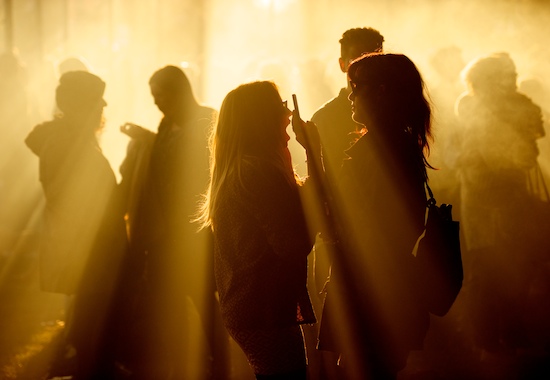12:00 – East India Youth, The Quietus Village Mentality Stage
If you will allow us an indulgence to begin, it’s fair to say that for m’colleague John Doran and I it was a proud moment indeed to see East India Youth up there on the Quietus Village Mentality Stage getting Field Day under way. Over the six months or so that we’ve been working with young William Doyle, his gigs have gone from strength to strength, the delivery of his Total Strife Forever material gathering ever more emotive heft. In this pre-lunch slot his capacity to create shredding electronic noise and soaring pop that can make one’s eyes moisten (we cannot pretend it’s all the pollen from the Victoria Park trees) is quite remarkable – so remarkable that Eat Your Own Ears ask him to play an extra slot later in the day on the Red Bull stage, where he has a similar effect on a crowd whose faces already resemble Dali clocks. – Turner
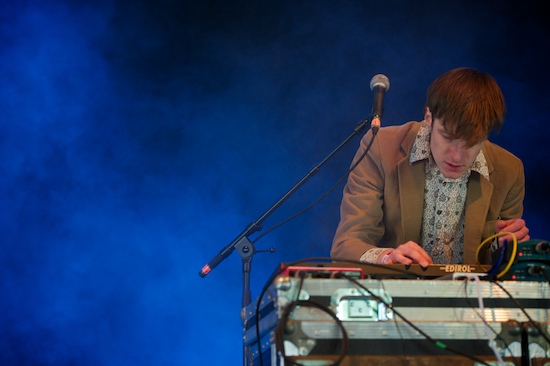
12:45 – Charanjit Singh, BleeD Stage
Charanjit Singh, in his 70s and sprightlier than I am most mornings, performs his album Ten Ragas To A Disco Beat. Though the record was produced outside acid house’s generally accepted time and place of conception (Bombay, 1982, rather than Chicago, 1987), its use of the Roland TR-808 drum machine and Jupiter 8 and TB-303 synths pretty much qualifies it as the genre’s precursor – the ur-‘Acid Trax’, if you like. "Rediscovered" and reissued in 2010, Ten Ragas To A Disco Beat is now performed to European audiences mostly born around the time acid house was a fully-fledged subculture, so the music feels at double remove from its context. Yet as Singh and his partner play wriggling acid lines and disco rhythms to a delighted audience, all those cultural and postcolonial implications of the tour (eloquently and touchingly explored by Singh’s tour manager Rana Ghose here are far in the back of my mind, if they were there at all. Instead, I feel deep respect for this aged man who with three machines manages to invoke the euphoria of a mid-80s rave in a Hackney park in 2013. – Kalev
14:05 – James Yorkston, The Quietus Village Mentality Stage
James Yorkston and co take up an early afternoon slot in the Village Mentality stage, arriving in time to soundtrack the gloomy interior becoming more firmly edged by sunlight. Yorkston’s joined by his Athletes, framing his melodic folk with violin, piano and particularly excellent vocal harmonies, and their deftness comes to the fore a few songs in on ‘Catch’. The opener from last year’s I Was A Cat From A Book, it’s an ineffably pretty song, the finger-picked notes falling out of Yorkston’s guitar steadily, then in more urgent eddies, gilded by tremulous piano and delicately-wrought violin.
Elsewhere, older material like ‘Tortoise Regrets Hare’ sparks with the intertwining of male and female voices. A few of the best moments come when Yorkston sings on his own or gets gently backed by single band members, with the violinist providing some of the finest points of the set, producing giddying, ghostly lines and runs that flail atop the band. ‘Spanish Ants’ is a short track on the album, but here it becomes a slow-burning grower, hung around a repeating keyboard line and layering up each instrument to make its melancholic chord progressions more momentous. – Tuffrey
15:20 – Thomas Mapfumo & The Blacks Unlimited, Eat Your Own Ears Stage Stage
As The Quietus arrive at the main stage the sun is shining and the crowd gathered for Thomas Mapfumo & The Blacks Unlimited are on their feet and dancing up a frenzy. Mapfumo commands the band from the front of the stage, singing and whistling over polyrythmic guitars interlaced with percussion and punctuated with blasts of saxophone and trombone. Mapfumo has played a very important role in the struggle for independence in his home country of Zimbabwe, his music and lyrics a call for change, with songs dealing in human rights, justice and African culture. But as his backing singers take to the stage, moving and shaking themselves into a whirl of colour, the high energy and joyous music have the crowd enthralled. Field Day erupts and tries their best to replicate the blistering moves they are seeing on stage, leading to one of the warmest displays we will see at a stage today. – McLeod
15:15 – Tim Burgess, The Quietus Village Mentality Stage

With islands of distantly thumping house music, nighttime soundtracks jerked forward unnaturally into mid-afternoon sun, surrounding our Village Mentality tent, you’d think odds would be against producing moments of intimacy, and yet that’s exactly what Tim Burgess manages to achieve with his set. Drawing on cuts from last year’s Oh No I Love You album, as well as an excellent, heartfelt cover of Arthur Russell’s ‘I Couldn’t Say It To Your Face’, any of the sound-bleed from outside is immediately zoned out by the languorous lilt and impressive falsetto of ‘The Economy’ or the disarming sweetness of ‘The Great Outdoors Bitches’. It’s hard to pick a highlight moment, but perhaps ‘Tobacco Fields’, founded on swathes of thick guitar chords and punctuated by Burgess’ baritone utterances, takes on a brilliant expansiveness and poignancy.
There’s also a huge amount to be said for watching a set which the performer enjoys as much as the audience – not that the other artists and bands weren’t having a good time at Field Day, but Burgess is evidently having a ball. Never a static figure, his blonde mop and Barbour coat wheel about the stage, sometimes humming out a guitar line or sharing a quick word with those standing on the side, and occasionally accentuating lyrics with a fist in the air or an unfurled palm. On reflection, it’s funny to think that the songs that make up Oh No I Love You weren’t, in a sense, Burgess’ to begin with; on the strength of this set, with each track run through with a lived-in warmth, it’d be hard to imagine them as anyone else’s. – Tuffrey
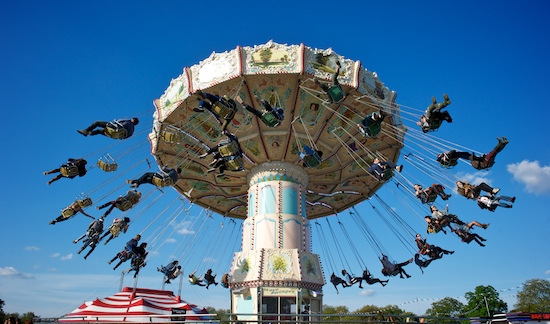
15:15 – How To Dress Well, BleeD Stage
"There’s like eight different beats," Tom Krell scolds us as we attempt to clap along to one of his songs. He gestures for us to stop and, gingerly, we do. Given the melancholic R&B Krell produces as How To Dress Well, you might assume him to be a hangdog sort of character, maudlin, self-absorbed. But as a performer, he takes no shit. Still, in spite of the singer’s boldness, his set is something of a cautionary tale against the hazards of transferring bedroom emotion to an over-packed tent on a sunny May afternoon. Sure, his repeated haranguing of the sound engineer ("the beat needs to be way louder") is partially justified – but you sense it’s also a crutch for his own unease, as his fiddly, slightly anaemic melisma fails to make more than a light impact on the assembled crowd. Gradually, though, Krell finds his stride, and by closer ‘Set It Right’, with its euphoric sheet-noise chords, it’s tingling spines all round. – Finlayson
16:20 – Savages, Laneway Stage
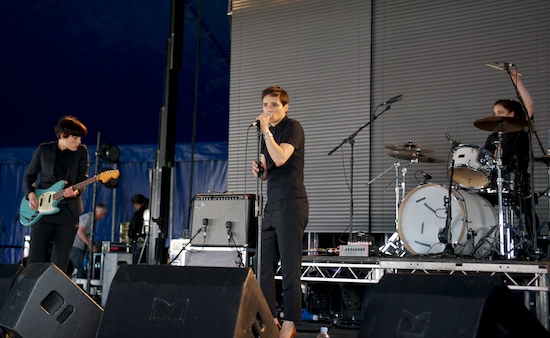
I wish more bands were like Savages. They might look and sound like a female-fronted Joy Division tribute band, from their throwback basslines to Jehnny Beth’s Ian Curtis haircut, but any criticisms of unoriginality people may level at their record are dispelled by their live show. Not wasting a second, they power through their forty-minute set with the kind of visceral brutality you’d be hard-pressed to find elsewhere in mainstream indie rock – or indeed, on the Field Day line-up. Beth’s voice is slightly smothered by the instrumentation, but she bristles with attitude, playing air-instruments and throwing herself around the stage with controlled chaos. Highlights include the under-two-minute thrill of ‘Hit Me’ and the no-fuck-about number ‘No Face’, but the best song is closer ‘Husbands’. As everyone pummels at their instruments violently and Beth shrieks the chorus like a deranged Patti Smith ("Husbands, husbands, husbands, husbands, husbands, husbands, husbands"), Savages don’t just resurrect the fearless, feral energy of their post-punk forebears – they make it their own. Kalev

16:30 – Ginger Baker
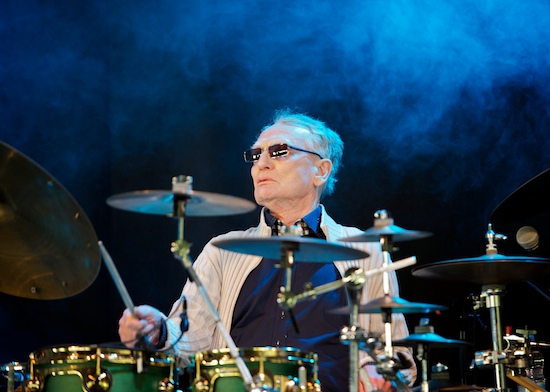
17:05 – Solange, Eat Your Own Ears Stage
5.05pm comes and 5.05pm goes, and yet there’s no sign of Solange at her appointed stage time. The soundcheck taking place is immaculate (befitting, as soon transpires, her band), but the no-stone-unturned, no cable-un-double-checked approach is getting to be irksome. Admittedly, the drummer does get a cheer for his own turn, kicking his bass-drum until it’s at sternum-punching levels (future Solange sound engineers, take note: turn all the drums up), but still.
After a final tweaking of the mic stand, Solange’s band emerge, and good lord, they look incredible: Dev Hynes, former Test Icicle and Knowles’ frequent collaborator, takes his seat behind the keyboards wearing a hat, shades and crisp petrol blue suit. The bassist, opting for a no-less-dapper suit and polo shirt combination, steps up in front while the two backing singers radiate smiles of Dayglo joy out into the crowd. They kick in with the propulsive groove of ‘Some Things Never Seem To Fucking Work’, and, just in time, for the first verse, out strides Solange herself, decked out in a brilliant geometrically-patterned shirt and flares. From the off, her performance is nothing short of mesmeric, her vocals either floating over buoyant synths or leaping ceaselessly around the upper registers. Not only that, but she takes the soonest opportunity to prance from side to side, sometimes in sync with the rest of the band, other times going it alone, each dance move greeted with whoops and cheers. And once she’s delivered the line "I was told it was going to be cold and rainy" before gesturing to the weather, which is evidently neither of those things, any delays are forgiven and the next 40 minutes are pretty much hers for the taking.
The seven tracks of last year’s True made for a slightly odd proposition, rendering it neither really EP nor album, and feeling just shy of fully-formed. Live, though, they make more sense – each track has evidently been worked hard on to give it its own imprint, any chaff cut away, and this translates into a concise, perfectly-formed set, augmented with a couple of deft song choices from elsewhere, primed for Solange’s festival slot. The space of ‘Locked In Closet’s intro, bass synth overwritten by itchy hi-hats, gets filled in later with her cover of ‘Stillness Is The Move’, the vocal dexterity of her and her backing singers impressively running rings around that of Dirty Projectors.
And, fitting with the down-to-a-tee nature of the set, Solange pauses for a moment before the last song, delivering a request that echoes one made on these pages, calling for cameraphones to be put away and "everyone just share in this fucking moment". And what a moment: the glitchy vocal loop from ‘Losing You’ wheels out and that bass drum thumps, initiating an immediate crowd surge. Despite the keening sadness of the synth pads and the lyrics, hinging on the moment of relationship breakdown, there’s not a hint of the song’s sentiment in the crowd: once Solange breaks the track down and brings it back for the chorus twice, and leaves the stage, there’s barely a face without a broad smile to be found. – Tuffrey
18:00 – Chris Watson Nature Disco, Caught By The River Stage

You’d think it’d be agony for a man with ears as finely tuned as Chris Watson to have to endure the sonic vomit that is the clashing PA systems of a music festival. No matter. In the Caught By The River tent, the waking grunts of lions, rustling undergrowth and hippos emerging from the water at night make up the former Cabaret Voltaire man turned documentary sound engineer’s set of "New tracks, new songs, animal sounds… All these tracks are part of a soundscape, just as we are now." Watson’s performance is as educative as it is sonically fascinating, with as much background information to each sound piece as you’d get from ten minutes of BBC programme. We hear a Masai joke that "hippos spend all day on the bottom of the river telling jokes, and come up onto the banks at night to laugh" and learn how the grey giants kill more people in Africa every year than any animal except mosquitoes.
The Caught By The River’s day of genteel entertainment and talks is focused around the art of the field recording, something that Watson takes literally with a recording of a field in the Australian outback. Sound is drawn up into metal fences then recorded by contact mics and hydrophones in the ground – chaos surrounds us all the time, but needs a Watson to tease it out. What’s remarkable is just how similar much of this is to Watson’s former work in the experimental music milieu. It turns out that frogs and toads are not dissimilar to reel-to-reel tape experiments, while a recording of the sound of vulture beak on zebra carcass bone is far more disquieting than anything you’ll ever hear from those who take inspiration from industrial music, but entirely miss the point. – Turner
Daphni, Hessle Audio, Disclosure – Bugged Out Stage
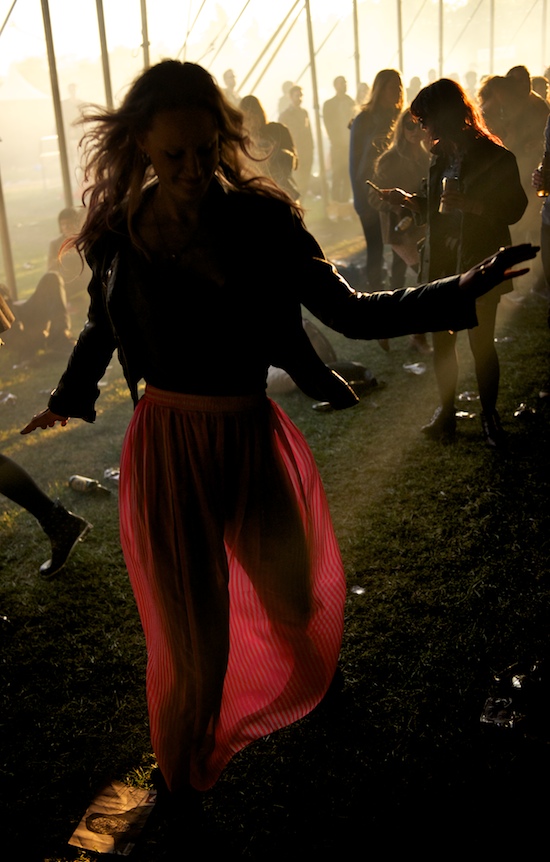
A sizable proportion of this writer’s afternoon is spent firmly planted at the Bugged Out stage, strolling amongst neon-sunglasses clad raver types and starry-eyed mid-afternoon dancers. Having not been to a festival of this scale for quite some time, it takes a while to become accustomed again to experiencing dance music in a space of this sheer size. It’s pretty alienating, really; no matter how close you move towards the front of the tent the DJ remains a pint-sized avatar in the distance whose actions seem to have little relationship with the sound hulking thickly from the PA. Equally, with the tent half-empty during the earlier hours of the day, everything but the incessant, chesty pound of the kickdrum diffuses outward into a murky cloud.
That’s why a mid-afternoon set from the ever on-point Hessle Audio triumvirate (Pangaea, Ben UFO, Pearson Sound) feels thinner than usual – admittedly not helped by the fact that the bulk of the crowd have vacated the premises, presumably to catch Solange playing elsewhere. As a collective whose DJ sets draw their power from a delicate balancing act between conserved momentum and depth-charge, drop-based impact, the Hessles’ deft switches in mood simply don’t pack as much punch in this space as they would in a dark basement. Instead, many dancers in the small audience present latch feverishly onto a four-to-the-floor pulse whenever it arrives, before losing interest slightly during long periods of broken, subby fare and chatting amongst themselves or contemplating heading elsewhere. As a result, the best moments are when the trio play it straightest (not usually something I’d write about the Hessle crew): a late set emergence of still-lovely lost Joy Orbison dub ‘GR Etiquette’, its glistening chords chiming with the sun’s rays creeping in from outside the tent, is a particular highlight.
The stage’s circus tent acoustics lend themselves much better to relatively more rhythmically straightfoward house and techno material – at least, they certainly do when the space is only half-full – hence the rest of the day featuring appearances from the likes of Julio Bashmore and Seth Troxler. Dan Snaith’s Daphni, who plays immediately before the Hessle trio, does an admirable job of filling the room with a disco, house and the odd bit of garage. He’s turning into quite the formidable DJ, switching between styles in a relaxed manner befitting his mid-afternoon time-slot and broadsiding the crowd with that whiplash modular bassline on ‘Ye Ye’.
Equally, you’ve got to give kudos to Disclosure, given the fact that they’re increasingly going to be spending their forthcoming summers resident on stages this size and larger, for scaling up the bombast of their performance accordingly. Admittedly, I hadn’t quite prepared myself for something quite so… stadium: drum kit, bass guitar and live sung vocals by the brothers Lawrence, plus visuals, crowd banter, the works. It’s far from being a straight-up club-inclined set of their serviceable pop-house tracks, instead opting to present them in more of a pop concert manner. Which is a fine and pleasant enough experience, albeit in a wearily resigned, caged wild animal kind of way (during Hessle’s final 15 minutes the tent rapidly fills with what feels like the entire festival’s worth of attendees, packed tight enough as to make escape challenging in the extreme).
Even in their short career, the duo have swiftly established themselves as one of those divisive acts – everyone has an opinion on them, or so it seems, and that opinion is usually one of either unfettered love or barely restrained rage. I find it hard to summon up enough energy to swing too far in either direction: sure, their take on house music is revivalist, polished and comfortably formulaic, but at the same time there are far worse crimes committed in the name of dance music on a weekly basis, they’ve got a deft enough knack with a melody and drums optimised to send shockwaves through big crowds like this, and the mood in the Bugged Out stage right now is as happy and excitable as I’ve seen all day. After my legs get tired and I’m bored of attempting to keep my footing among the shifting mass of bodies I slowly squeeze my way towards the exit. I can’t tell you what tracks they did play, but ‘White Noise’ certainly didn’t drop before I was well out of earshot, hotfooting it for a stern seeing-to from Karenn at the BleeD stage. – Gibb

18:20 – Connan Mockasin, Shacklewell Arms Stage
If we were scoring solely on costumery, Connan Hosford and gang could feel confident of their chances. Their presence transforms the Shacklewell Arms stage into a miniature paisley amnesty; Hosford himself looks like a pantomime witch hunter, his diminutive form obscured by a floppy broad-brimmed hat and oversized cape. Clearly the band are intent in living out their skewiff psych-pop fantasy to the letter. It’s a laudable goal, although given the band’s rushed, slightly patchy performance, you wonder whether it came at the expense of rehearsal time. A few swatches of material from a forthcoming second album are intriguing, seeming to swap rickety psychedelia for slightly bolder pop gestures. Elsewhere the creeping strangeness of 2011’s Forever Dolphin Love is replaced by the faintest hint of psych-rock bombast; as in a version of ‘Faking Jazz Together’, where the original’s midpoint detour into sinister stasis is glossed over in favour of a more rigid sense of propulsion. The finale, a rendering of ‘Forever Dolphin Love’, manages to stay true to its puckish fluctuations in mood and intensity. Live, though – and with the band already overrunning their allotted slot – it takes on a newfound urgency, the final section breaking out into a head-on dash for the finish line: proof that Hosford can strike a balance between eccentricity and vigour when he wants to. – Finlayson

20:00 – Karenn, BleeD Stage
Blawan and Pariah, together as Karenn, have released a couple of 12" that I have to admit I’ve so far greeted with not much more than a shrug. Karenn’s utilitarian brand of techno is obviously better suited to a 4am slot in Corsica Studios than an 8pm one at a London festivat, but I needn’t have worried. Not only do Karenn deliver an all-hardware set that strikes the right balance between practiced tracks and beats made on the fly, it happens to be exactly the kind of music I felt like hearing. Rather than the po-faced 90s throwback techno I’d been expecting, the set is, well, really ravey. Everything I enjoyed about the records is there – kickdrums so huge they verged on the ridiculous, and craggy textures that makes the music sound as if it had been hewn from rocks. But instead of the industrial bleakness typical to the records, live Karenn are more playful, so the entire BleeD tent – and the spillover outside – is throwing serious shapes as the sun went down. In retrospect, it feels odd to draw parallels between Charanjit Singh, the accidental acid house innovator, and these two merchants of hammer-to-the-cranium techno, but the vibe they impart really wasn’t dissimilar at all. Kalev
20:20 – Do Make Say Think, The Quietus Village Mentality Stage
Toronto’s Do Make Say Think were one of the bands lumped with the ‘Post Rock’ tag due to their mostly instrumental music, but unlike others they have continued to put out excellent records to this day and to little fanfare. Their records are intricate and intimate – which is a hard thing to translate live let alone on a festival stage. They open with a synth heavy version of ‘End Of Music’ and from the onset it is seems they are going to bludgeon the audience and hammer home their trademark ebb and flow rather than rely on subtleties. Their set draws songs from their back catalogue, with tracks like ‘Fredericia’ coming over like a storm on a tin roof, two drum kits tuned to different timbers locked into interwoven rhythms, loud bursts of distortion and effect laden guitars building endless crescendos and at the centre Charles Spearin’s anchoring bass. As they launch into ‘Do’ from most recent album The Other Truths a beaded man nearby howls and raises his skinny fists to the sky in praise. There are bigger crowds gathered around other stages at this time in the evening, but the ones here are in on the little secret and witnessing something magic. – McLeod
21:50 – TNGHT, Bugged Out Stage

With a tent full of the sun-fatigued and hazy-eyed duly spilling over, Hudson Mohawke and Lunice close the Bugged Out stage by animating their collaborative project with great ferocity. Their cuts, hulking pieces of instrumental trap, sound steel-riveted enough on record, but transferred to the red tent’s towering rig take on a new, sharpened potency. In between twin metal scaffolds and shrouded in permanent smoke, Lunice jabs frenetically at his sampler while the taller Mohawke remains more static, moving only to light up mid-set, both surrounded by retina-scorching columns of LEDs strafing the tent with spotlight glare. Despite the evident perspiration going into forging their music, the sounds coming from the speakers feel mechanised, only palimpsestic traces of human influence lingering in their precision-tooled heft. Strobing synth melodies and pitchshifted vocals dart between cluster bomb snares, while the kicks are more distant descendants of bass drums, mutated here into vast depth-charges that underpin the whole set, occasionally ramping up into double-time flurries, wreaking havoc on E3’s tectonic integrity with each pummelling.
‘Goooo’, one of the most played tracks from last year’s self-titled EP, sweeps in mid-set, its spasming synth line razing in time to burning blue and white flashes, and gets followed by Chief Keef and Kanye West cuts, before – and seemingly all too soon – the familiar handclaps and dizzying vocal repeats of their calling card ‘Higher Ground’ rear into earshot. The juddering, descending brass riff, almost comically obnoxious, is coming, and everyone’s anticipating it. There’s momentary stasis, and then there it is, blaring out across our heads before a final wrenching on the guts of an 808 leaves the tent a flailing mass of limbs, all swaying devotedly to the track’s leering swagger which comes again and again and again. Moment of euphoria had, ground bass-riven, Mohawke and Lunice depart. – Tuffrey
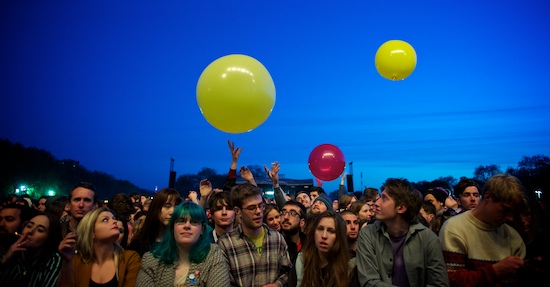
20:50 – Fucked Up, Shacklewell Arms Stage
London crowds are self-absorbed, po-faced, noncommittal. They don’t dance, they don’t sing along – any outward display of emotion, in fact, beyond a carefully cultivated air of boredom, is strictly prohibited. It’s a tired line of criticism, and not, for the most part, an accurate one. But, after wandering into the Shacklewell Arms tent to see Fucked Up, it’s difficult to suppress a mounting sense that the rest of us should feel ashamed of ourselves. Who are these people who succeed in generating a low-intensity mosh pit within seconds – one whose raucous brownian motion steadily grows until the entire crowd is captive to its logic? Have they bothered with any of the other bands, or did they just bosh fifty quid on a ticket for this 30 minute onslaught of high-octane pop jouissance, this and nothing else? You sense that this level of audience fervour is par for the course for Fucked Up: vocalist Damian Abraham, topless, sweaty and overflowing with bonhomie, spends the majority of the set draped across the front row, trading lyrics with die-hard fans and enduring a steady hail of back pats and high fives. It’s as if I’ve wandered into another festival, another dimension even – one where we are all fifteen again, bands are our gods, gigs our frenzied communion – and it’s the most brilliantly life-affirming thing I’ve seen in months. – Finlayson
21:50 – Mulatu Astatke, The Quietus Village Mentality Stage
In the run-up to the release of his new album Sketches Of Ethiopia, Mulatu Astatke and his band are on the road, bringing the Ethio Jazz that Mulatu pioneered – a fusion of jazz concerns with Afro rhythms and Coptic melodies – to European audiences. Closing Field Day on The Quietus’ stage, Mulatu and his band seem to sum up everything that had been the fluidity that characterised the festival’s programming: Mulatu occasionally takes a break from vibraphone to play the timpani, the sax player briefly switches to flute, and the trumpeter also plays shaker percussion, so that though the set really only has one mood and colour, it never went for long without a shift. Whether Mulatu and his band played crowd favourites – the theme from Jim Jarmusch’s film Broken Flowers predictably drew the most applause – or songs from his new album, the audience hang on every rich, clear vibraphone note. Mulatu thanks the audience with real happiness and sincerity, and as we start tramping out of Victoria Park, we all share a silly grin, as affected by the band’s warmth and camaraderie as by the songs they had played. – Kalev
Massive thanks to everyone from Field Day and Eat Your Own Ears, and of course all the artists who played on the Quietus stage

